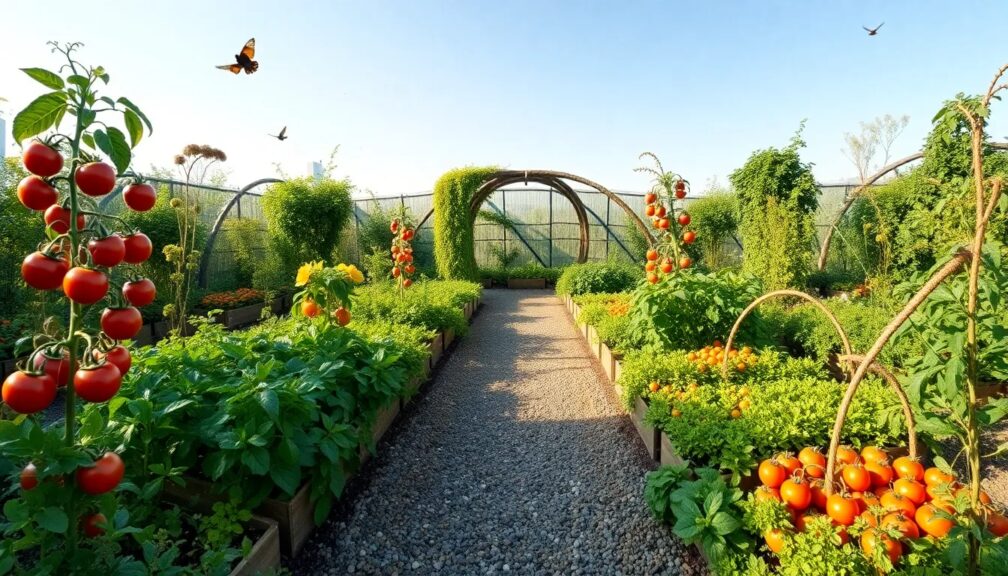What is the best layout for a vegetable garden

Unlocking the Secrets to the Ideal Vegetable Garden Layout
Discovering the perfect arrangement for a vegetable garden can transform your gardening experience. Whether you're a beginner eager to plant your first seeds or an experienced green thumb looking to optimize your harvest, understanding the best layout is crucial. In this article, we delve into various garden designs, spacing strategies, and the principles of companion planting to help you create a flourishing and productive garden. Learn how to make the most of your space, ensure your vegetables receive ample sunlight, and improve soil health for a bountiful yield season after season. Join us as we explore the key components of the best layout for a vegetable garden that caters to both aesthetic pleasure and practical success.
Which vegetables grow well together chart?
Discover the secrets of the vegetable kingdom with a comprehensive guide that unveils the perfect plant pairings for your garden. Imagine stepping into your backyard oasis, ripe with the lush greenery of thriving vegetables. The key to such a bountiful harvest lies in knowledge that's been cultivated for generations: the art of companion planting.
Companion planting is more than just a gardening trend; it's a time-tested method that naturalists and seasoned growers swear by. But what makes certain vegetable combinations a match made in horticultural heaven? It's all about understanding the subtle relationships between different plants and how they can benefit each other when grown in close quarters.
For instance, did you know that tomatoes and basil not only make a classic culinary pairing but also support each other’s growth when planted side by side? Or that the humble marigold can be more than just a pretty face in your vegetable patch, acting as a natural pest deterrent to protect your precious produce?
Unlock the chart that holds the key to a thriving garden ecosystem. By delving into this treasure trove of agricultural wisdom, you'll learn which veggies to plant together to enhance growth, deter pests, and even improve the flavor of your homegrown delights. From the nitrogen-fixing properties of legumes that can enrich the soil for their leafy neighbors to the intricate dance of shade and sun requirements, every piece of wisdom is a step towards a more fruitful garden.
Whether you're a seasoned gardener or a green-thumbed novice, the fear of missing out on peak harvest potential is real. Don’t let uncertainty cloud your gardening dreams. With the right information at your fingertips, you'll be equipped to transform your garden into a vibrant tableau of healthy, happy plants that have been expertly matched for success.
Intrigued? You should be. Your garden, and your taste buds, will thank you. Get ready to discover combinations that will maximize yield, discourage pests, and bring a new level of organization and beauty to your green space. The journey to the ultimate garden harmony starts now.
Which vegetables should not be planted next to each other?
As you delve into the world of gardening, it's essential to unlock the secrets of companion planting. Imagine cultivating a vibrant, thriving vegetable garden only to see it falter – not because of pests or poor weather, but due to the silent underground battles between your chosen veggies. It's a reality that, without proper knowledge, could spell disaster for any green thumb enthusiast.
Picture walking through your garden, with its immaculate rows of greenery, only to find patches of wilting, struggling plants. The culprit? Unknowingly, you might have paired incompatible companions, creating a scenario where growth is stunted, nutrients are competed over, and pests run rampant.
For instance, planting tomatoes and corn together might seem harmless, but it's a sure-fire recipe for trouble. These two compete for the same nutrients and are targets for the same pests, doubling your problems. Similarly, keeping strong-herbed plants like onions and garlic away from legumes such as beans and peas is crucial, as their potent aroma can inhibit the growth of these sensitive legumes.
Don't fall victim to these easily avoidable mistakes! With the right knowledge, your garden can become the envy of the neighborhood – a lush, bountiful oasis bursting with health and productivity. Stay tuned, as we uncover more of these vital combinations to avoid and ensure your garden's success. Your journey to becoming a master of companion planting is just beginning, and missing out could mean the difference between a mediocre harvest and a spectacular one.
What is the best path for a vegetable garden?
Imagine stepping into your own lush oasis, a symphony of greenery where every vegetable thrives and each step brings you closer to nature's bounty. The secret to such an enchanting garden isn't just in the seeds you sow but also in the paths you tread.
The journey to creating an idyllic vegetable garden begins with a well-thought-out blueprint. The paths you choose can make or break your gardening dreams, acting as crucial arteries that flow life and ease throughout your verdant paradise.
First, consider the allure of curved pathways. They invite a sense of mystery and exploration, leading you on a meandering journey through your vegetable beds. The curves can follow the natural contours of the landscape, creating an organic flow that feels as if Mother Nature herself had a hand in its design.
But don't overlook the practicality of straight walkways. They exude a sense of order and efficiency, allowing you to access every corner of your garden with ease. The linear perspective can also give the illusion of length, making your garden seem larger and more abundant.
The width of your paths is more than just a measurement—it's a gateway to communal gardening. Wide enough to walk side by side with a fellow green thumb, these paths can foster shared experiences and knowledge, turning solitary gardening into a social affair.
Choosing the right materials for your garden paths is akin to selecting the perfect pair of shoes for a long journey. They need to complement the surroundings while providing durability and comfort. From the natural elegance of pebble mosaic to the rustic charm of wooden chips, the materials you choose can enhance the aesthetic while ensuring functionality.
As you consider the best path, remember that this isn't just about treading on soil – it's about creating a living, breathing work of art that will not only feed your body but also your soul.
The best path for your vegetable garden is out there, waiting to be discovered. With each choice tailored to your unique landscape and lifestyle, you'll create a haven that beckons you to delve deeper, harvest more, and immerse yourself in the wonders of homegrown abundance. Don't your taste buds deserve the freshest, most vibrant produce, handpicked from a garden that's as beautiful as it is productive?
Stay tuned as we dig deeper into the essentials of garden path design, unveiling tips and tricks that will turn your green space into the envy of every gardener on the block.
How to stagger vegetable plantings?
Imagine harvesting fresh, crisp vegetables from your garden not just once, but throughout the entire growing season. Yes, it's possible – and the secret lies in mastering the art of staggered planting. This technique allows you to extend the bounty of your garden, providing a continuous supply of home-grown produce that could be the envy of your neighbours.
So, how do you turn your garden into a conveyor belt of delicious, nutritious veggies? The answer is simpler than you might think. Here are the steps you need to follow:
1. Understand Your Crops
Before you even put a seed in the soil, you need to know which vegetables are suitable for staggered planting. Cool-season crops like lettuce and spinach can be planted in early spring and again in the fall. Warm-season crops, such as beans and tomatoes, thrive when planted after the last frost and can often be replanted mid-season for a later harvest.
2. Plan Your Timing
Timing is everything. By planting seeds or seedlings at regular intervals – say, every two weeks – you ensure that your garden will produce successively. This means you won't have all your lettuce maturing at once but rather a steady flow ready for your salad bowl.
3. Utilize Succession Planting
Succession planting is not just about when you plant, but also where. For example, after harvesting early-season radishes, you can plant a crop of carrots in the same space. This method keeps the soil active and maximizes garden space efficiency.
4. Practice Interplanting
Interplanting involves growing fast-maturing crops alongside slower-growing ones. Plant radishes between rows of carrots, and by the time the carrots need more room, the radishes will have been harvested. This is a clever way to get the most out of every square foot of your garden.
Intrigued? There's more to learn about making your vegetable garden a sustainable, all-season producer. But to unlock the full potential of staggered planting, you'll need to dive deeper into each of these techniques. The rewards are undeniable: a garden that keeps on giving, the freshest produce at your fingertips, and the satisfaction of self-sufficiency.
Stay tuned, as we'll explore the intricacies of soil health, pest management, and crop selection to ensure your staggered vegetable plantings are nothing short of spectacular. Get ready to transform your gardening approach and indulge in the ultimate homegrown experience.
Vegetable garden layout plans and spacing
Imagine stepping into your own backyard and being greeted by rows of luscious tomatoes, vibrant peppers, and fragrant herbs. With the right layout and spacing, this dream can become your reality. Crafting the perfect garden plan is like painting a masterpiece, where each vegetable plays a pivotal role in the harmony of your edible landscape.
Firstly, consider the sun's path and your garden's orientation. A south-facing garden maximizes sunlight, ensuring your veggies get the energy they need. But beyond the basics, there's a secret to transforming your garden into a high-yielding oasis: it's all in the details.
Visualize your space with raised beds or neatly delineated plots, each with a purpose and plan. Here's where the magic happens. Intercropping, the practice of growing different crops in close proximity, can bolster your garden's health and productivity. Imagine carrots and tomatoes thriving together, their roots intertwining below the soil, a technique that saves space and minimizes weeds.
But wait, there's more to uncover. Have you ever heard of companion planting? This is where the true potential of your garden is unlocked. By placing certain plants side by side, you can deter pests naturally and promote vigorous growth. The secret companionship between basil and tomatoes is not just a culinary delight but a strategic alliance against insects.
And what about row spacing? Forget the guesswork and imagine utilizing precise measurements that allow for optimal growth and air circulation. No more overcrowded plants competing for resources; instead, each vegetable has its own territory to flourish.
Picture these strategies in action and feel the FOMO start to set in. You're on the brink of elevating your gardening game, ensuring each inch of soil is used to its fullest potential. This is not your average garden plan; it's a blueprint for abundance. Stay tuned, and you'll uncover the keys to a garden that's not only productive but also a stunning testament to thoughtful design.
Consejo final: Research your plants' needs and design your layout for optimal sunlight exposure, efficient watering, and ease of harvest. Remember to rotate crops annually to maintain soil health. May your garden flourish with abundance! Wishing you success in your gardening adventures.
 What do I need to start gardening
What do I need to start gardening What is the best tool for turning soil
What is the best tool for turning soil What is the best tool to trim bushes and trees
What is the best tool to trim bushes and trees What is the best tool to plant plants
What is the best tool to plant plants How do you get rid of tree roots without digging
How do you get rid of tree roots without diggingIf you want to know more about similar articles like What is the best layout for a vegetable garden you can visit category Gardening Tools.
Deja una respuesta